Click on images to enlarge
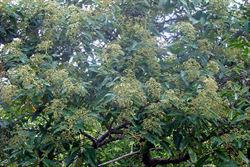
habit in flower (Photo: Sheldon Navie)

habit in fruit (Photo: Land Protection, QDNRW)
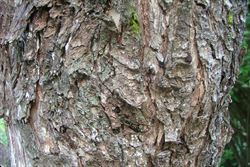
old trunk (Photo: Sheldon Navie)

young leaves pressed together (Photo: Sheldon Navie)
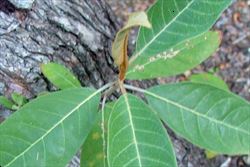
orange-coloured new growth (Photo: Sheldon Navie)

close-up of leaf (Photo: Sheldon Navie)

young flower cluster (Photo: Sheldon Navie)
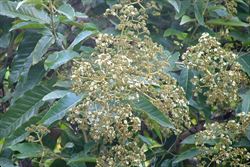
flower clusters (Photo: Sheldon Navie)
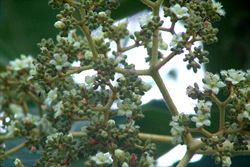
close-up of flowers (Photo: Sheldon Navie)
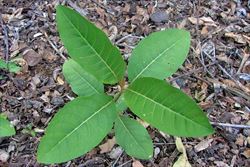
young plant (Photo: Sheldon Navie)
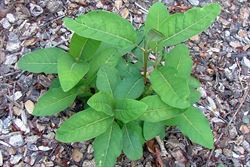
root suckers (Photo: Sheldon Navie)
Scientific Name
Harungana madagascariensis Lam. ex Poir.
Family
Clusiaceae (Queensland, New South Wales, the ACT, Victoria, Tasmania, Western Australia and the Northern Territory)Guttiferae (South Australia)
Common Names
dragon's blood tree, haronga, harungana, orange-blood, orange-milk tree, praying hands bush, praying-hands
Origin
Native to tropical Africa (i.e. Sudan, Kenya, Tanzania, Uganda, Burundi, Cameroon, Equatorial Guinea, Rwanda, Zaire, Ivory Coast, Gambia, Ghana, Guinea, Liberia, Mali, Nigeria, Senegal, Sierra Leone, Angola, Malawi, Mozambique, Zambia and Zimbabwe), Madagascar and Mauritius.
Cultivation
This species was probably cultivated as an ornamental tree in gardens the wetter parts of northern Australia.
Naturalised Distribution
Not yet widely naturalised in Australia, and currently only found in the wetter tropical areas of far northern Queensland (particularly near Babinda).
Habitat
A potential weed of disturbed rainforests, forest gaps and margins, roadsides and drainage areas in tropical and sub-tropical regions.
Habit
A small to relatively large tree usually growing 10-15 m tall, but occasionally reaching up to 20 m in height. It can sometimes also grow as a large multi-stemmed shrub.
Distinguishing Features
- a large multi-stemmed shrub or tree with younger stems covered with star-shaped hairs.
- its oppositely arranged leaves have dark green upper surfaces and undersides covered with rusty-brown hairs.
- its new growth is yellowish-orange in colour and the developing pairs of leaves are tightly pressed together.
- its leaves and young branches exude a bright orange sap when damaged.
- its small whitish-coloured flowers are arranged in dense clusters at the tips of the branches.
Stems and Leaves
The stems are covered with fine star-shaped (i.e. stellate) hairs and the young growth (i.e. the branch tips and young leaves) are yellowish-brown to orange in colour. Branches and young leaves exude a bright orange coloured sap when damaged.
The leaves are oppositely arranged, and the young leaves at the tips of the branches are tightly pressed together (i.e. hence the common name "praying hands"). Mature leaves are relatively large (10-20 cm long and 6-10 cm wide) and egg-shaped in outline (i.e. ovate) or almost oval (i.e. elliptic) in shape. They have rounded (i.e. obtuse), wedge-shaped (i.e. cuneate) or almost heart-shaped (i.e. sub-cordate) bases and pointed tips (i.e. acute or shortly acuminate apices). These leaves are borne on stalks (i.e. petioles) 15-20 mm long and have numerous prominent veins on their undersides. The upper leaf surface is dark green and hairless (i.e. glabrous), while the lower leaf surface is covered with rusty-brown coloured hairs.
Flowers and Fruit
The small whitish coloured flowers are very numerous and arranged in dense clusters at the tips of the branches (i.e. in terminal corymbose panicles). The branches of these flower clusters are covered with coarse rusty-coloured hairs and the fragrant flowers are dotted with black glands (i.e. they are punctate). Each flower has five tiny sepals, five small whitish petals that are somewhat hairy, and numerous small stamens that are arranged into five clusters (i.e. fascicles). Flowering occurs throughout the year, but mostly during late spring and early summer.
The small rounded fruit (2.5-3.5 mm across) look like tiny 'berries' (they are actually drupes) containing 2-4 hard seeds. These fruit turn brown as they ripen and are borne in large clusters at the tips of the branches.
Reproduction and Dispersal
This species reproduces mainly by seed, but it also spreads laterally via the development of suckers from its roots. The seeds are mostly dispersed by fruit-eating (i.e. frugivorous) birds.
Environmental Impact
Harungana (Harungana madagascariensis) is regarded as an environmental weed Queensland and as a "sleeper weed" in other parts of northern Australia. It its native habitat, in tropical Africa, it grows as a 'pioneer' tree on the margins of wet forests and in forest gaps after disturbance events. In Australia, this species has invaded cyclone-damaged rainforest, as well as forest fringes, roadsides and riparian areas in the wet tropics of northern Queensland. Harungana (Harungana madagascariensis) grows at all altitudes and can form dense thickets to the exclusion of other species. Its spreading roots produce suckers, and so do damaged plants, enabling it to out-compete other species. By spreading in this fashion, harungana (Harungana madagascariensis) is able to quickly dominate the canopy, and infestations over a few hectares have been found that consist almost exclusively of this species.
In 1992, harungana (Harungana madagascariensis ) was listed as one eight species of weeds that were potentially the most destructive to native plant communities in the Wet Tropics World Heritage Area. So far it is mainly found along forest verges between Innisfail and Babinda. However, researchers have found it thriving well within undisturbed rainforests in Wooroonooran National Park, in small gaps created by tree falls and landslips. A large proportion of the infestations were contolled in the 1990s, but in the absence of follow-up control it has begun to spread again.
Although harungana (Harungana madagascariensis) is currently restricted to relatively disturbed areas, there is concern that this plant may become a permanent component of tropical rainforest communities. Some experts believe that it has the ability to completely decimate huge sections of the Wet Tropics World Heritage forests, given the right circumstances (e.g. major canopy damage caused by cyclones).
Legislation
This species is declared under legislation in the following states and territories:
- Queensland: Class 3 - this species is primarily an environmental weed and a pest control notice may be issued for land that is, or is adjacent to, an environmentally significant area (throughout the entire state). It is also illegal to sell a declared plant or its seed in this state.
- Western Australia: Unassessed - this species is declared in other states or territories and is prohibited until assessed via a weed risk assessment (throughout the entire state).
Management
Similar Species
Harungana (Harungana madagascariensis) is quite distinctive, and can be readily distinguished by its orange sap and yellowish-brown to orange coloured growing tips.

